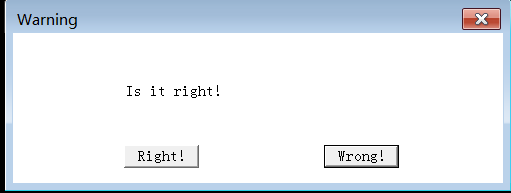public class MsgBox : System.Windows.Forms.Form { Label bodyLabel = new Label(); Button yesBtn = new Button(); Button noBtn = new Button(); public MsgBox() { } public MsgBox(string titleMsg, string bodyMsg, string yesMsg,string noMsg) { this.ClientSize = new System.Drawing.Size(490, 150); this.Text = titleMsg; yesBtn.Location = new System.Drawing.Point(111, 112); yesBtn.Size = new System.Drawing.Size(75, 23); yesBtn.Text = yesMsg; yesBtn.BackColor = Control.DefaultBackColor; yesBtn.Click += YesBtnClick; noBtn.Location = new System.Drawing.Point(311, 112); noBtn.Size = new System.Drawing.Size(75, 23); noBtn.Text = noMsg; noBtn.BackColor = Control.DefaultBackColor; noBtn.Click += NoBtnClick; bodyLabel.Location = new System.Drawing.Point(111, 50); bodyLabel.Text = bodyMsg; bodyLabel.Font = Control.DefaultFont; bodyLabel.AutoSize = true; this.BackColor = Color.White; this.ShowIcon = false; this.Controls.Add(noBtn); this.Controls.Add(yesBtn); this.Controls.Add(bodyLabel); } private void YesBtnClick(object sender, EventArgs e) { this.DialogResult = DialogResult.Yes; } private void NoBtnClick(object sender, EventArgs e) { this.DialogResult = DialogResult.No; } }
static void CustomizeMsgBoxDemo() { MsgBox msgBoxForm = new MsgBox( "Warning", "Is it right!", "Right!", "Wrong!" ); msgBoxForm.FormBorderStyle = FormBorderStyle.FixedSingle; msgBoxForm.MaximizeBox = false; msgBoxForm.MinimizeBox = false; msgBoxForm.StartPosition = FormStartPosition.CenterParent; DialogResult dlgResult=msgBoxForm.ShowDialog(); if(dlgResult==DialogResult.Yes) { MessageBox.Show("Right!"); } else { MessageBox.Show("Wrong!"); } }

Copy and update from
https://stackoverflow.com/questions/12704026/how-to-change-text-on-messagebox-buttons
WPF edition.
<Window x:Class="WpfApp1.MsgBox" xmlns="http://schemas.microsoft.com/winfx/2006/xaml/presentation" xmlns:x="http://schemas.microsoft.com/winfx/2006/xaml" xmlns:d="http://schemas.microsoft.com/expression/blend/2008" xmlns:mc="http://schemas.openxmlformats.org/markup-compatibility/2006" xmlns:local="clr-namespace:WpfApp1" mc:Ignorable="d" Title="MsgBox" Height="300" Width="400"> <Grid> <Grid.RowDefinitions> <RowDefinition/> <RowDefinition/> <RowDefinition/> <RowDefinition/> <RowDefinition/> </Grid.RowDefinitions> <Grid.ColumnDefinitions> <ColumnDefinition/> <ColumnDefinition/> <ColumnDefinition/> <ColumnDefinition/> <ColumnDefinition/> </Grid.ColumnDefinitions> <Label Grid.Row="2" Grid.Column="1" Grid.ColumnSpan="3" x:Name="bodyLabel" HorizontalAlignment="Left"/> <Button Grid.Row="3" Grid.Column="1" x:Name="yesBtn" Click="YesBtnClick"/> <Button Grid.Row="3" Grid.Column="3" x:Name="noBtn" Click="NoBtnClick"/> </Grid> </Window>
.xaml.cs
using System; using System.Collections.Generic; using System.Linq; using System.Text; using System.Threading.Tasks; using System.Windows; using System.Windows.Controls; using System.Windows.Data; using System.Windows.Documents; using System.Windows.Input; using System.Windows.Media; using System.Windows.Media.Imaging; using System.Windows.Shapes; namespace WpfApp1 { /// <summary> /// Interaction logic for MsgBox.xaml /// </summary> public partial class MsgBox : Window { public MsgBox() { InitializeComponent(); } public MsgBox(string msgTitle,string msgBody,string yesMsg,string noMsg) { InitializeComponent(); this.Title = msgTitle; this.bodyLabel.Content = msgBody; this.yesBtn.Content = yesMsg; this.noBtn.Content = noMsg; WindowStartupLocation = WindowStartupLocation.CenterScreen; WindowStyle = WindowStyle.SingleBorderWindow; ResizeMode = ResizeMode.NoResize; } private void YesBtnClick(object sender, RoutedEventArgs e) { this.DialogResult = true; } private void NoBtnClick(object sender, RoutedEventArgs e) { this.DialogResult = false; } } }
invoke
private void MsgDemo() { MsgBox msgBox = new MsgBox("Right or wrong?", "Is this description right?", "Right", "Wrong"); bool? dlgResult = msgBox.ShowDialog(); if(dlgResult==true) { MessageBox.Show("Right!"); } else { MessageBox.Show("Wrong!"); } }